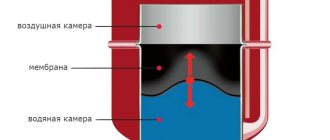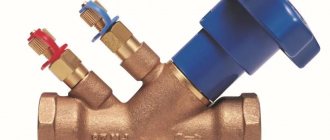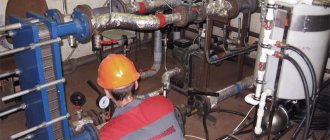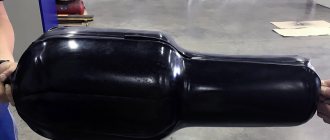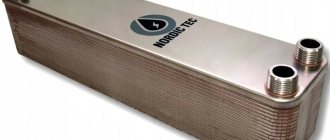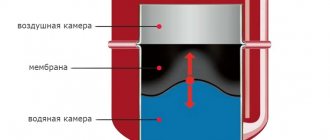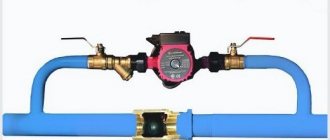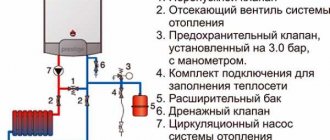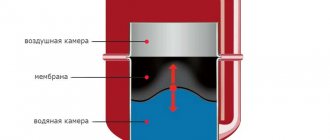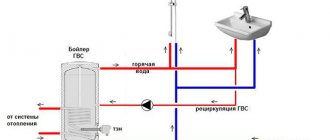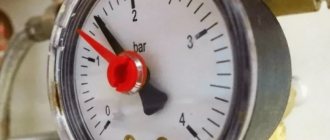The stability, reliability, efficiency and durability of the heating system depend on how correctly all its parameters are calculated, how harmoniously its devices, components and necessary devices interact with each other, how well the installation and adjustment are performed. And there simply cannot be trifles in such matters.
It would be completely unreasonable to divide individual devices and components into “important” and “not so important”. Yes, the cost of elements can vary very significantly, the functionality of some is constantly visible, while others are completely invisible and even incomprehensible from the point of view of an inexperienced user. But each performs its own “mission” in the overall operation of the system. Therefore, for example, the question looks completely amateurish: is the expansion tank really that important for a heating system, and is it worth attaching importance to the problem of its selection and correct installation? Meanwhile, the importance of this simple device is difficult to overestimate.
How to determine the required expander volume?
The volume of the expander must exceed the value of the required volume, which represents the maximum amount of coolant entering the tank as a result of its heating.
First of all, the total volume of coolant in the system is determined. By summing the internal volume of pipes and cavities of all system elements (boiler, heating radiators, shut-off valves), we obtain the total volume. The amount of liquid in pipelines can be calculated depending on the size of the pipe, using the data in Table 1. The volume of equipment cavities is indicated in the documentation (passport or manufacturer’s catalog) for the product.
Table 1 - Determination of the volume of coolant in 1 linear meter of pipeline.
Next, knowing the total amount of liquid, determine the required volume of the expander using the data in Table 2. This value is selected depending on the pressure in the system. If the previously calculated value is between two tabular ones, the required tank volume is determined by the larger of the values.
Table 2 - Determination of the required volume of the expansion tank.
The data in Table 2 is valid if water is used as a coolant. For liquids with a coefficient of thermal expansion different from water, the tabulated value of the total volume is multiplied by a correction factor equal to the ratio of the density of water and the liquid used.
Why is an expansion tank needed in a heating system?
When the coolant is heated, the pressure in the boiler and the heating system circuit increases significantly due to the temperature increase in the volume of the coolant fluid.
Considering that the liquid is a practically incompressible medium and the heating system is sealed, this physical phenomenon can lead to the destruction of the boiler or pipelines. The problem could be solved by installing a simple valve that could release the excess volume of hot coolant into the external environment, if not for one important factor. When cooling, the liquid contracts and air enters the heating circuit in place of the discharged coolant. Air jams are a headache for any heating system; they make circulation in the network impossible. Therefore, it is necessary to bleed air from heating radiators. Constantly adding new coolant to the system is very expensive; heating cold water is much more expensive than heating the coolant that came into the boiler through the return pipeline.
This problem is solved by installing a so-called expansion tank, which is a reservoir connected to the system by one pipe. Excess pressure in the heating expansion tank is compensated by its volume and allows for stable operation of the circuit. Externally, expansion tanks for the heating system, based on the calculation results and the type of heating circuit, are different in shape and size. Currently, tanks are produced in various shapes, from classic cylindrical tanks to so-called “tablets”.
Design and principle of operation
A membrane tank is a hermetically sealed metal container divided into two compartments (chambers) by an elastic membrane. One such chamber is a pneumatic chamber, which contains gas or air under pressure. The coolant enters the second chamber, the hydraulic chamber.
The device operates as follows:
- the air pressure, which is in a state of equilibrium, in the pneumatic chamber compensates for the fluid pressure in the heating system, the volume of the coolant and the hydraulic chamber is reduced to a minimum;
- when the fluid pressure increases in the system, including during heating, the pressure also increases in the hydraulic chamber, where excess coolant flows;
- due to the elasticity of the membrane, the volume of the pneumatic chamber decreases, which is accompanied by an increase in gas pressure;
- when the pressure in the pneumatic chamber increases, the increase in pressure in the hydraulic chamber is compensated, and the system returns to a state of equilibrium.
When the coolant pressure in the system decreases, the opposite occurs. Gas (air), compressed in the pneumatic chamber, expands and displaces liquid from the hydraulic chamber into the system until the pressure difference is restored. The design eliminates the possibility of contact between the coolant and air, reducing the likelihood of rust not only in the tank, but also in other parts of the heating system - piping, boiler. Sealed expansion tanks are equipped with safety valves that allow you to limit the maximum pressure in the heating system to an acceptable level. This characterizes the tank as a protection device for the heating system.
Extender maintenance
In order for the product to work properly over a long period, it is necessary to properly care for it.
Tank maintenance involves regularly performing simple activities.
Among them the following stand out:
- Twice a year it is necessary to inspect the system for mechanical damage and corrosion.
- 2. The pressure in the system should be checked every six months.
- 3. When performing any repair or maintenance work, you need to check the condition of the separation membrane.
- 4. If the device is not used for a long time, it is necessary to drain the liquid from the expansion tank and dry it thoroughly.
- 5. Monitor pressure and temperature indicators, and also avoid large changes.
- 6. When replacing one of the structural elements, you must use only branded parts.
How to check and pump up the expansion tank
Before connecting and filling the tank with coolant, it is necessary to check the pressure in the air chamber of the tank for compliance with the pressure in the heating network. To do this, a plastic plug is unscrewed or removed from the side of the air compartment, and under it there is a regular spool, familiar to you from car cameras. You measure the pressure with a pressure gauge and adjust it to your system by pumping it up with a pump or releasing it by pressing the spool rod.
For example, the design pressure in the network after filling should be 1.3 Bar. Then in the air compartment of the expansion tank you need to make 1 Bar, that is, 0.2 Bar less. The trick is to keep the rubber “bulb” of the tank pressed against the water side. Otherwise, when cooling, the compressed coolant will begin to draw air through automatic air vents, which is unacceptable. After setting up, open the tap, fill the entire system with coolant and calmly start the boiler.
Note. Some manufacturers indicate on the packaging of their products the factory pressure in the air compartment. Using it, you can choose a suitable tank and not bother with pumping.
Setting up the tank for operation in the heating system, taking into account differences and pressure levels
How to start the tank after installation? It is necessary to correctly calculate the pressure level in the network, taking into account the following indicators:
- Pst is the static pressure, which will be equal to the height of the water column, determined by the height of the overall heating system from the point of installation of the tank to the top element;
- P0 is the air pressure in the gas (air) chamber of the tank;
- Pstart is the initial pressure for recharging the equipment;
- Pext – settings for the pressure created in the system;
- Pkon – the level of pressure that is created as a result of additional replenishment;
- Pkl – pressure level for the safety valve (for private houses this pressure can be 3 bar);
- Pmax is the level of maximum operating pressure for which the boiler heat exchanger is designed (it is the element of the entire heating network that is most sensitive to this parameter).
We recommend: Making wooden portals for a fireplace with your own hands
Where is the expansion tank installed for heating?
The location of the tank depends on the type of heating system and the purpose of the tank itself. The question is not why an expansion tank is needed, but where it should compensate for the expansion of water. That is, in the heating network of a private house there may be not one such vessel, but several. Here is a list of functions that are assigned to tanks installed in different places:
- compensation of thermal expansion of water in open heating systems;
- the same for closed systems;
- serve as an addition to the standard expansion tank of a gas boiler;
- handle the increasing volume of water in the hot water supply network.
An open-type reservoir, where the coolant is in contact with atmospheric air, is the hallmark of an open heating system. In this case, the installation of the expansion tank is carried out at the highest point of the heating network of a private house. Often such systems are made gravity-flow with increased pipeline diameters and a large amount of coolant. The capacity of the tank should be appropriate and be about 10% of the total volume of water. Where else if not in the attic to put such a large tank?
For reference. In old one-story houses you can often see small expansion tanks for an open heating system installed in the kitchen next to the floor-standing gas boiler. This is also correct; a container located under the ceiling is easier to control. True, it doesn't look too good in the interior. To put it mildly.
Alternative homemade tanks
Closed-type heating systems are distinguished by the fact that the membrane expansion tank for water can be placed anywhere. But still, the optimal installation option is in the boiler room, next to the rest of the equipment. Another place where it is sometimes necessary to install a closed expansion tank for heating is the kitchen in a small house, since the heat source itself is located there.
About additional capacities
Following new trends, many manufacturers equip their heat generators with built-in reservoirs that absorb the volume of coolant that increases when heated. These vessels cannot fit all existing heating schemes, and sometimes their capacity is not enough. To ensure that the coolant pressure during heating is within normal limits, in accordance with the calculation, an additional expansion tank is installed for the wall-mounted boiler.
For example, you converted an open gravity system into a closed one without replacing the mains. The new heating unit was selected according to the heat load. Whatever capacity it contains, it will not be enough for that amount of water. Another example is underfloor heating in all rooms of a two- or three-story building plus a radiator network. Here, the volume of coolant will also be impressive; a small tank will not cope with its increase and the pressure can increase significantly. That is why a second expansion tank for the boiler is needed.
Note. The second tank to help the boiler is also a closed membrane container, located in the furnace room.
When the hot water supply to the house is provided by an indirect heating boiler, the question also arises - where to go with the water that expands when heated. One option is to install a relief valve, as is done on electric water heaters. But the indirect heating boiler is much larger in size and it will lose too much hot water through the valve. What better way to select and install an expansion tank for a boiler.
For reference. Buffer tanks (heat accumulators) from some manufacturers also provide the ability to connect a compensating tank. Moreover, experts recommend installing it even on large-capacity electric boilers, as shown in the video:
Recommendations for choosing a container
The most important feature that you should pay attention to when choosing an expansion tank model is the volume of its tank. For closed systems with a small circuit, the volume of coolant in which does not exceed 150 liters, the capacity is easy to calculate.
So, it should be:
- when using water as a coolant - 10% of the volume of the entire heating system (for example, if this figure is 100 liters, then the expansion tank must hold at least 10 liters);
- when using glycol liquid as a coolant - 15% of the volume of the heating system.
In the latter case, the capacity should be larger due to the greater expansion coefficient of the specified antifreeze.
The advantage of modern expansion tanks is the reaction of their membrane to any change in coolant temperature. Which guarantees safety of use. But it should be remembered that tanks are designed to operate in certain conditions, so they must be selected correctly
The volume of the tank for larger systems, the circuit of which circulates more than 150 liters, is most conveniently calculated using the parameter of the total volume of the system and a table for selecting a tank.
To calculate the total volume of the system, you can use the following methods:
- Measure the volume of coolant circulating in all individual elements of the system (boiler, radiators, pipelines) and then sum up the results obtained. This method is highly labor intensive, but at the same time it is the most accurate.
- Multiply each kilowatt of boiler power by 15, assuming that on average there are about 15 liters of coolant per 1 kW. This method is simple, but you should remember that you can trust the result only when you are confident in the correct selection of the heating element for the system.
- Drain all water from the system and refill it, calculating the required displacement.
We recommend: Why heating radiators make noise in an apartment: causes and solutions.
You can also use formulas or an online calculator to calculate the required volume of the tank. Why is it necessary to know the volume of coolant, its temperature and pressure in the system.
The method with formulas is more complex and the volume obtained as a result of calculations will not differ significantly from the rough calculation given above. Moreover, the found value must be rounded up.
Many manufacturers of expansion tanks offer the consumer assistance in selecting the right tank. To do this, tables are provided to make selection easier. However, they must indicate that the information provided is advisory in nature and the buyer bears responsibility in any case.
The most practical solution when choosing will be an expansion tank designed for closed-type heating systems, equipped with a safety valve.
The reason is that when the pressure rises to critical standards, the device will start working and bleed it. That is, this valve can significantly increase the safety of the entire heating system.
When purchasing a container, you should take into account that red paint is most often used to mark expansion tanks used for heating.
This feature will help to distinguish the desired product from other similar ones, for example, water supply tanks of similar size and shape - hydraulic accumulators, which are mainly covered with blue enamel.
But if necessary, you can find tanks of various colors, which will help you place the one you need in any room without compromising its aesthetic qualities.
Containers can be horizontal or vertical, and manufacturers also provide the opportunity to mount them in different places. For this product, they are equipped with various accessories. And when purchasing, you should pay attention to this, determining the best option in advance.
When choosing, you should also pay attention to the quality of the materials used in the production of the container body and membrane. And the presence of a guarantee for the purchased equipment and instructions for installing and connecting it to the system.
What does the system consist of and how does it work?
In order for heat to flow from the boiler room to the heating devices, a mediator is used in the water system - liquid. This type of coolant moves through a pipeline and heats rooms in the house, all of which can have different areas. This factor makes such a heating system popular.
The coolant can move naturally; circulation is based on the principles of thermodynamics. Due to the different densities of cold and heated water and the slope of the pipeline, water moves through the system.
One of the important elements of the heating system is the open expansion tank; excess heated liquid enters here. It is this element that stabilizes the coolant pressure. The main condition is that the tank should be located at the highest point of the heating system.
Open heating operates according to the following scheme:
- The boiler heats water and supplies it to heating devices in every room of the house.
- On the way back, excess liquid goes into an open-type expansion tank, its temperature drops, and the water returns to the boiler.
Single-pipe heating systems involve the use of one line for supply and return. Two-pipe systems have independent supply and return pipes. When deciding to install a dependent heating system yourself, it is better to choose a single-pipe scheme; it is simpler, more accessible and has a basic design.
Single-pipe heat supply consists of the following elements:
- Heating boiler.
- Batteries or radiators.
- Expansion tank.
- Pipes.
A simplified scheme involves using pipes with a cross-section of 80-100 mm instead of radiators, but it should be borne in mind that such a system is less efficient in operation.
Advice from professionals
During installation work, you need to take into account not only the manufacturer’s recommendations, but also the advice of professionals. This will help you avoid most mistakes and complete your work in a minimum amount of time.
Expert recommendations:
- It is recommended to paint all elements of the heating system red. This will help to easily distinguish them from models designed for cold water supply.
- 2. The process of boiling liquid in the system is not related to the operation of the expansion tank. Most often this occurs when the slope of the pipelines and their diameter are insufficient.
- 3. Do not install the expander near the pump, as this can lead to sudden pressure changes.
- 4. To seal joints, you should use special compounds designed to work at high temperatures.
- 5. When installing the tank, you need to leave free space, which will be needed for repairs or maintenance.
- 6. In some modern models, the expander is already built-in, so there is no need to buy additional equipment for the same purpose.
A closed expansion tank is an important element of the heating system, which allows you to increase operating efficiency and reduce the risk of an emergency. With proper installation and maintenance, the tank can serve owners for many years.
System components
Open-type heating in a private house requires the installation of a boiler that runs on solid fuel or fuel oil. The fact is that this type of heating is characterized by the periodic formation of air pockets, which can cause an accident when using electric and gas boilers.
You can calculate the power of a heating boiler using a standard scheme, according to which heating 10 m2 of room area requires 1 kW of energy plus 10-30%, depending on the quality of the thermal insulation.
You should not use polymers as a material for the expansion tank; steel would be the best option in this case. The volume of the tank depends on the area of the heated room; for example, in the heating system of a small building one floor high, an expansion tank of 8-15 liters can be used.
As for the pipes for the heating system circuit with a circulation pump, in this case the following materials can be used:
- Steel. This pipeline is characterized by high thermal conductivity and resistance to high pressure. However, installation has some difficulties and requires the use of welding equipment.
- Polypropylene. This system is characterized by easy installation, durability and tightness; it can withstand temperature fluctuations. Polypropylene pipes have been characterized by flawless operation for a quarter of a century.
- Metal-plastic. Pipes made of this material are resistant to corrosion; deposits do not form on their internal walls, which would impede the natural movement of the coolant. However, the cost of such a system is quite high, and its service life is only 15 years.
- Copper. A copper pipeline is considered the most expensive, but it can withstand high temperatures, up to +500 degrees, and is characterized by maximum heat transfer.
Coefficient of increase in the volume of water in a water-glycol mixture depending on temperature
To determine the coefficient “k” of expansion of the coolant volume, it is necessary to use special tabular data. This coefficient shows how the volume of antifreeze additives in the coolant changes with temperature expansion. When making calculations, it is necessary to take the value of the operating temperature of the coolant and the corresponding coefficient. For water as a coolant, the coefficient of ethylene glycol is “0”; for antifreeze, the value must be calculated taking into account the tabular data.
In addition, the coefficient can be calculated in this way - 4% x 1.1 = 4.4%. This value is observed if the amount of ethylene glycol in the system is up to 10% of the total coolant volume. If the amount of ethylene glycol is up to 20%, then the coefficient is calculated as follows - 4% x 1.2 = 4.8%. In this case, the value will change as the temperature in the system increases. For example, if the temperature reaches 80 degrees, then the coefficient will be equal to 0.029, if the amount of ethylene glycol is 10%, then the coefficient will be 0.032, when using water and ethylene glycol in a ratio of 50%/50%, the coefficient will be 0.0436.
How to choose the right expansion tank for a heating system? It is necessary to take into account not only the type and total volume of the system, but also the length of the circuit for each room, type of pipelines, coolant and many other parameters. It is necessary to take into account where the tank will be located and what requirements apply to its operation.
Types of expansion tanks
Now understanding the importance of such equipment, the reader has a new reasonable question: “What type of tank is best to buy for your home?” For a complete answer, you will first need to study the product options that exist on the modern domestic market. Let's get started with the review without delay.
Such devices are becoming more and more common. They can be purchased at large retail chains, for example, “Leroy Merlin” or “Moya Rodnya”
Open type – massively popular, elementary simple
This modification is the most common and accessible not only in our country, but throughout the world. It is so simple that anyone can make such a device at home. Structurally, an open expansion tank can serve as any container that has an inlet hole for the coolant to enter, as well as a cutout in the upper part for evaporation of liquid. Accordingly, as the pressure increases, water penetrates into the expander, partially evaporates, and when the temperature drops, it returns back to the system for further circulation.
Despite its simplicity, it is better to purchase a factory-made model - it is more reliable and easier to use.
Closed type (membrane tank) - ready for serious testing
If the previous option is more suitable for heating with natural water supply into pipes, then the next, more advanced nominee is also suitable for complex tasks. The secret is that the design of the membrane expansion tank includes two chambers, different in composition and properties. The first, external, is filled with either ordinary air or inert gas (depending on the price tag). The second, internal, is a hollow empty space where the coolant ends up over time. Between the cavities there is a membrane made of plastic rubber. Initially, a certain pressure is created in a closed-type apparatus. When water enters the internal cavity of the tank, the membrane partition changes its shape, maintaining normal operation of the system. When cooled, the gas or air from the outer chamber expands and pushes liquid out of the expansion tank. Thanks to this device, a closed expansion tank can compensate for the load created by a circulation pump or other artificial supercharger.
Installation of a membrane expander requires considerable skill and knowledge, and ideally, the services of a specialized specialist
It is also important to note the fact that this type of device has two subtypes. The first, with a membrane in the form of a diaphragm (disc)
It has a more affordable price, but if it breaks, the product cannot be repaired
The first, with a membrane in the form of a diaphragm (disc). It has a more affordable price, but if it breaks, the product cannot be repaired.
Low plasticity indicators negatively affect the available useful internal volume of equipment
And the second, with a membrane in the shape of a “pear” (balloon). It features a simple system for replacing a worn partition and a large internal chamber volume.
This shape also allows you to experiment with different pressure values to find the perfect fit.
Battery type - for the most prudent owners
This unusual invention has not yet gained wide popularity among the residents of our country, but it is worthy of mention. The peculiarity and main function of this “miracle of technology” is the accumulation of coolant in its body and its subsequent transfer at the required moment into the system. Accordingly, the battery expander does not combat excess pressure; it simply improves the heating efficiency in a house or apartment.
The high-tech device is capable of storing water at different temperatures, supplying it to the system according to predetermined “scenarios”
Common problems
Expansion tanks, like any other heating units, are subject to a number of specific problems. Let's get to know them.
The most common breakdown of such units is the rupture of the membrane part. As a rule, this occurs due to too high pressure (above normal) or uneven loads. Please note that replaceable elements break much more often than compressed ones, since stronger materials are used for the latter, because they can be changed at any convenient time.
The problem of a damaged membrane can lead to many unpleasant consequences. For example, this often causes water to leak from the air valve.
If the membrane is not replaced in time, its rupture will lead to the fact that over time the tank will simply fail. This is due to the fact that liquid gets on the inner surface of the tank, after which it can become covered with rust and become unusable.
Please note that the old membrane should be replaced with the same part. It is advisable to contact a specialized service center for this.
Also, users quite often encounter damage to the tank body. If such a problem occurs with your equipment, it is better for you to seek help from a specialist. Do not attempt to repair damaged cabinet elements yourself, especially if you have never encountered such work before.
There are also cases when the expander boils. Most often, this problem occurs in homemade open-type structures. The main essence of this problem is the lack of circulation speed (or its complete absence).
Here are the main reasons for such breakdowns.
- Reduced wiring diameter. The main single-pipe heating circuit is usually installed with a pipe that is no less thin than DN 32.
- No slope. After the heating boiler, you need to make a so-called accelerating manifold. To do this, the pipe must be raised to the upper section of the circuit, where the expander is installed. The remaining part of the contour should be laid with a downward slope.
Many users are wondering how to fix such a serious problem without completely dismantling and reinstalling the heating system. The answer is simple - you need to install a circulation pump. This part works great in many systems (especially the open type). The pump must be placed on the return line directly in front of the boiler.
Another problem with expansion tanks is air blockage in the heating system circuit. To avoid colliding with it, you need to monitor the volume of water.
If you do not replenish it, the resulting evaporation will lead to the above problems.
Useful tips
It was already mentioned above that the volume of the expansion tank is equal to 10% of the volume of the entire coolant in the heating system of the house. Of course, this is an approximate figure. To accurately determine it, it is necessary to take into account a large number of various coefficients that are included in a complex formula. It will be difficult to make such a calculation on your own, if you are not a specialist. Therefore, take the above ratio as a basis.
By the way, if the safety valve trips very often, you know that you missed the volume. Most likely, you incorrectly calculated the total volume of coolant. In this case, do not rush to replace the installed expansion tank with a new one with a larger volume. You can simply insert another one next to it so that it compensates for the missing liters.
When the question arises of how to install the piping of the expansion tank, there are only two points to consider:
- The coolant must enter it from the top point.
- And leave from the very bottom.
Expansion tanks of open and closed type
This is how you can avoid mixing air with water inside the tank.
Very often, ordinary people ask why the expansion tank is boiling? There are two reasons:
- The diameter of the contour pipe is incorrectly selected. Usually a reduced diameter leads to boiling, so experts advise using pipes of at least 32 mm. But also take into account the fact of correct installation of heating radiators. They should not rupture the pipe system, but crash into it.
- Lack of slope of the contours, which we have already discussed above. Therefore, you will have to redo the heating system or install a circulation pump in it.
A few words about the pump. It was already mentioned above that open-type heating and a circulation pump are not always compatible. If you increase the volume of coolant, then a low-power pump can be inserted into the circuit. And this will solve the problem. By the way, they install it on the return circuit near the boiler. How to increase the volume of coolant? Option one is to increase the diameter of the distribution pipes. You can also increase the sections of heating radiators. In general, everything will need to be calculated and thought through. You shouldn't make hasty decisions.
DIY installation
Before proceeding with the installation of the expander, it is important to prepare:
- be sure to read the instructions before starting work;
- carry out all the necessary calculations of temperatures and pressure indicators (usually all this data is indicated in special reference books on standards for the use of units);
- prepare tools such as a wrench, a wrench for installing plastic pipes;
- if the tank has a large capacity, then you will also need to buy brackets - they will be useful for mounting.
When installing and connecting such units, you should rely on some recommendations from specialists:
- position the unit in such a way as to guarantee free access to it in the future;
- provide for the likely dismantling of pipes in the future;
- make sure that the diameter of the connecting pipe matches the connected water supply;
- correctly install the required temperature sensors;
- calculate the connection of shut-off valves.
Now you can proceed to the actual installation of the tank. It should be hung near the inlet of the flowing coolant in the direction of the heating unit.
Mark areas for fastening. Drill the required number of holes needed to secure the bracket. To do this, attach it to the wall and mark all areas of the connection. Having made all the necessary holes, you need to install anchor bolts in them, then hang the bracket and make sure that the fastening is secure. If everything is done efficiently, then you can install the tank itself, and then secure it with clamps.
Please note that such equipment cannot be installed in sub-zero temperatures. In addition, it is important to ensure that the air valve is in an accessible area after completion of installation work. This is necessary so that the owners have the opportunity to set the desired pressure level.
Absolutely all mechanisms that require adjustment must be in the public domain, and pipes must be located so that they do not create loads on the equipment.
As for such an element as a pressure reducer, it must be installed after connecting the measuring meter, so as not to encounter serious loads directed at the tank. This valve must be attached in front of the flow pipe.
After this, you need to configure the installed expansion tank. First you need to set the required pressure level. This must be done by pumping air. The pressure gauge will indicate when you need to stop. After this, water is pumped in using a pump, the pressure is equalized, and the membrane part is brought into a floating state. Then the tank can be considered ready for use. You may need to turn on the system and make sure it is working.
As you can see, the installation and connection diagram of the expansion tank is quite simple. Anyone can cope with such events.
The main thing is to rely on the instructions and be extremely careful at every stage.
Place for installing a membrane type expansion tank
Usually they place an expansion tank on the return pipeline in front of the circulation pump (if you look in the direction of flow of the coolant). A tee is installed in the pipeline, a small section of pipe is connected to one part of it, and an expander is connected to it through fittings. It is better to place it at some distance from the pump so that pressure differences are not created. An important point is that the piping section of the membrane tank must be straight.
Installation diagram of an expansion tank for membrane-type heating
A ball valve is installed after the tee. It is necessary to be able to remove the tank without draining the coolant. It is more convenient to connect the container itself using an American nut. This again makes installation/disassembly easier.
Please note that some boilers have an expansion tank. If its volume is sufficient, installing a second one is not required.
The empty device does not weigh much, but when filled with water it has a significant mass. Therefore, it is necessary to provide a method of mounting on the wall or additional supports.
The heating expansion tank can be hung on a bracket
Make a support platform The tank on legs can be installed on the floor
Types of tanks
Compensation tanks for heating networks differ in shape, design, and internal size.
Open type equipment
They are a rectangular or cylindrical container with an open top, where you can always add water if necessary. Most often, such tanks are made of sheet steel and are thermally insulated. They are installed at the highest level of heating networks with natural circulation.
The design includes the following elements:
- containers of various sizes;
- inlet pipe for supplying coolant;
- outlet pipe for water return;
- control pipe that prevents overflow.
The main disadvantages of open expansion tanks are their large size, tendency to corrosion, the need to add water and constant monitoring.
Closed type device and its functions
Suitable for heating networks where the movement of coolant is provided by pumps. Externally it looks like a closed oval or spherical container with a pipe for connecting to the heating network and a nipple on the reverse side. A membrane is installed inside the tank, dividing the cavity into two chambers: one is filled with gas (air or nitrogen), the other is intended for liquid.
If the circuit is not heated, the tank is empty; when the temperature rises, the excess coolant is directed into the tank, increasing pressure in another chamber. When this parameter reaches the limit level, the valve is activated and excess gas is released. As the liquid cools, it contracts and is pushed back into the circuit. All processes occur automatically.
Photo 1. Closed expansion tank, volume 50 l, steel, without replaceable membrane, .
Closed devices are available in two designs.
With flanged replaceable diaphragm
The main features of expansion devices of this type:
- Water does not come into contact with the walls of the device, remaining inside the membrane cavity - eliminating the risk of corrosion and contamination of the coolant.
- Possibility of replacing the elastic chamber through a bolted flange.
- They have higher maximum pressure values than models with a non-replaceable diaphragm.
- Horizontal and vertical design - convenient to place in boiler rooms of different configurations.
With stationary membrane
The internal space is divided in two by an elastic butyl diaphragm, which is rigidly attached to the walls of the chamber.
Initially, the entire cavity is occupied by gas, so the membrane is pressed against the walls. During heating, the liquid enters the tank, the gas is compressed, and the pressure increases.
80ffce45030ada9c3069748facadb954.jpe
Water comes into direct contact with the inner surface, which creates a risk of corrosion. To prevent the destruction of the metal, a moisture-resistant coating is applied to the inside of the tank walls.
The main advantages of devices with a non-replaceable membrane are their affordable price and variety of design options.
Attention! The main disadvantage is that if the diaphragm fails, the tank will have to be replaced with a new one. Closed expansion equipment is allowed to be installed close to the heating boiler - on the side of the pump inlet pipe
Closed expansion equipment is allowed to be installed close to the heating boiler - on the side of the pump inlet pipe.
Advantages and disadvantages
A closed expansion tank, like any other product, has its advantages and disadvantages. They must be taken into account before installation, which will avoid unforeseen situations that can bring many problems to the owners of a private home.
Among the advantages are the following:
- simplicity of design; ease of installation;
- no need to control and regulate the coolant level;
- the ability to use antifreeze without fear of defrosting the system;
- by changing the amount of liquid supplied to the system, you can adjust the room temperature;
- a closed tank prevents water evaporation and eliminates the need to replenish it from external sources;
- the possibility of upgrading the system and installing additional heating sources;
- pressure adjustment can be done independently;
- the device is highly technologically advanced and cost-effective;
- With proper care, the tank can last for a long time.
Despite the large number of advantages, a closed expansion tank also has several disadvantages. They lead to increased financial costs and decreased efficiency.
The negative aspects include:
the need for constant availability of power supply;
- significant financial costs for additional equipment that will ensure uninterrupted operation of the device (small generator);
- at the slightest violation of the tightness, air will enter the system and reduce heat transfer;
- large dimensions of the product;
- the need to purchase special installations that help maintain the required pressure in the system;
- high cost of the finished device and its individual elements.
Installation of expansion tank
After making calculations, you can begin installing the heating expansion tank
It is important to choose its location correctly in the overall diagram. This directly depends on the type of system - gravity or forced circulation
Despite the fact that the role of the expansion tank in heating will remain unchanged, incorrect installation can lead to malfunctions.
Open design
Installation diagram of an open expansion tank
An open expansion tank is installed at the highest point of the system.
Some experts recommend installing it immediately after the accelerating vertical line. By adding water to the system through the expansion tank, the likelihood of backflow is reduced. Also, in this place in the circuit, the temperature of the coolant is usually the highest and, accordingly, its expansion. You can also connect to the return pipe. But then the operation of the expansion tank in the heating system will be less efficient.
Before installation, we recommend that you familiarize yourself with the general rules and tips:
- Small deviations horizontally and vertically of the structure are allowed. But they should not exceed 2-3°;
- Insulation can be done using basalt wool. She is not afraid of humidity, and most importantly, high temperatures;
- If the pressure inside the heating expansion tank exceeds critically, some of the liquid may fall through the top cover onto the attic floor. It is recommended to provide improved waterproofing of the floor in this area.
A scheduled inspection of the condition of the tank can be done 2 times a month with constant heating operation and always before the first start of the system.
Diaphragm tank
Installation diagram of a membrane expansion tank
Installation of a membrane expansion tank in heating systems is carried out only on the return pipe in front of the circulation pump.
A prerequisite is compliance with the temperature regime in the room. The air heating level should not be less than +5°C. Installation must not be obstructed by foreign objects. The same applies to structural maintenance.
The correct installation of the expansion tank in the heating system is to maintain its level. The structure must stand strictly vertically. Even a slight tilt may cause incorrect operation. For safe servicing, an air valve should be installed on the air chamber to quickly reduce the pressure in it in the event of an emergency.
It must be remembered that the location of the expansion tank in the heating system must not only be technically correct, but also convenient for its maintenance.
The fundamental difference between the operation of an expansion tank in a closed-type heating system is the possibility of its quick dismantling. Therefore, it is recommended to install 2 shut-off valves during installation - one on the inlet pipe to the heating system, and the second on the water chamber of the tank. By blocking them, you can quickly dismantle the container to repair it or install a new one.
The video material presents the design features of expansion tanks and their role in the operation of the heating system:
Types of heating systems
There are two schemes for building heating networks - open and closed. An open (gravity) heating system is used in centralized heating networks and allows water to be directly withdrawn for hot water supply needs, which is impossible in private housing construction. Such a device is located at the top point of the heating system circuit. In addition to leveling pressure drops, the heating expansion tank performs the function of natural separation of air from the system, since it has the ability to communicate with the outside atmosphere.
Thus, structurally, such a device is a compensation tank of the heating system, not under pressure. Sometimes a system with gravitational (natural) circulation of a heat-carrying fluid may be mistakenly called open, which is fundamentally incorrect.
With a more modern closed circuit, an expansion tank of a closed-type heating system with a built-in internal membrane is used.
Sometimes such a device can be called a vacuum expansion tank for heating, which is also true. Such a system provides for forced circulation of the coolant; air is removed from the circuit through special taps (valves) installed on the heating devices and at the top of the system pipelines.
Calculation time - how to determine the required volume of the expansion tank
Having understood the classification and choosing the most suitable option for your purposes, you need to calculate the minimum allowable volume of the tank. For comfortable heating operation, a container containing 10% of the volume of coolant in the system is sufficient. To calculate the amount of all water in pipes and radiators, two variable methods are used:
- measurement of displacement when directly filling the system with water or other coolant;
- calculation of the capacity of all pipes and radiators located in the heating circuit.
For such purposes, you can use canisters or other containers, the volume of which is already known.
To calculate the volume of pipelines, use the table below:
| Pipe internal diameter, mm | Volume of water in 1 linear meter, l |
| 14 | 0,1539 |
| 16 | 0,2011 |
| 18 | 0,2545 |
| 20 | 0,3142 |
| 22 | 0,3801 |
| 24 | 0,4524 |
| 28 | 0,6158 |
| 32 | 0,8042 |
| 36 | 1,0179 |
| 40 | 1,2566 |
| 50 | 1,9635 |
To calculate the volume of heating batteries, you can use the following average values:
| Radiator material | Liquid volume in 1 section, l |
| Cast iron | 1,7 |
| Bimetallic alloy | 0,25 |
| Aluminum | 0,45 |
Having completed all the necessary calculations, you can immediately find 10% of this value. Or use a special formula that will give a more accurate and objective result:
V= VL β / D
- VL – heating system capacity, l;
- β – liquid expansion coefficient;
- D – efficiency of the expansion tank.
To calculate the last indicator in the formula, we perform the following calculation:
D = (PV-PS) / (PV-1),
where PV is the maximum value of operating pressure in the system, bar; PS – pressure in the tank without load, bar.
A special antifreeze, which has its own expansion coefficient, can be used as a heating fluid
Guide values for water content in heating systems
When planning a heating system and choosing an expansion tank, you should immediately determine in what volume the water circulating through the pipes and radiators will be used. Typically, the volume of the tank is 10% of the total volume of water; for an accurate calculation, the following formula is used: Vb = Vc × k / D, where:
- Vb – working volume for the expansion tank used;
- Vс – total volume of coolant;
- k – coefficient of volumetric expansion of the coolant;
- D – efficiency coefficient (determined for the expansion tank).
To calculate the total volume, you can use three methods:
- using a water meter, measure how much water circulates through the system in one cycle;
- For accurate calculations, a formula is used for summing the entire volume of pipes for the general circuit of the system, the capacity of the boiler heat exchanger, radiators, convectors and other equipment;
- Another method assumes that per 1 kW of system power there are 15 liters of coolant, that is, the nameplate power of the boiler must be multiplied by 15, obtaining the total volume of water.
Features of arranging open heating
Classic open heating equipment
A classic open-type heating system for a private home differs from a closed one in terms of pressure. It is equal to atmospheric. Therefore, to arrange this type of heat supply, significantly fewer components and accurate calculations are required. But this does not mean that an open heating scheme can be drawn up unprofessionally.
To automatically stabilize the coolant pressure in the pipes, the system provides an open expansion tank for open heating. It is the design of this component that distinguishes an open heat supply scheme from a closed one. The coolant can move in two ways:
- Due to thermal expansion of hot water. For this, an accelerating riser is required. According to this scheme, an open heating system with natural circulation is designed;
- Installation of pumping equipment. It allows you to increase the speed of coolant movement. A pump in an open heating system is necessary if the total length of the lines exceeds 25 m.
In addition, it is necessary to reduce the friction of water as it passes through the pipes. To do this, the diameter of the latter must be at least 30 mm. Otherwise, hydraulic resistance will increase, which will reduce natural circulation.
The defining component in the scheme is the boiler for an open heating system
It is important not only to choose the correct design and operating principle of the device, but also to follow all installation rules
How to replace?
From the above information we can conclude that the main problem with expansion tanks is a damaged membrane. Many users encounter this problem. Experts recommend replacing these elements in special service centers, but it is possible to carry out such work yourself.
This is done as follows.
- First you need to disconnect the tank from the heating system.
- Next, you need to reduce (reset) the pressure of the gas cavity using the nipple on top of the unit.
- Remove the diaphragm flange located next to the nozzle to connect the pipeline. By unscrewing the nut on top of the housing, you need to release the membrane part holder.
- Remove the membrane part from the cavity at the bottom of the housing.
- Next, you need to examine the surface of the interior of the hull structure. There should be no dirt or rust. If there are any, they must be removed and the surfaces washed with water. Then you need to dry the case.
- It is important to take into account the fact that the membrane is not resistant to oil. For this reason, products containing oil should not be used to ensure that the insides of the unit are protected from corrosion.
- Install the membrane element holder into the cavity located at the top of the membrane itself, if such fasteners must be present in the design of a particular device.
- Screw the bolt into the retaining element and place the membrane in the housing. The holder must be inserted into the cavity located at the bottom of the housing.
- The retaining part must be secured with a nut.
- Set the preliminary values for the air pressure in the expander. Check the structure for leaks, after which you need to connect the expander directly to the heating system.
How to make it yourself from plastic containers or stainless steel
You can make an expansion tank yourself. A tank of 10-12 liters is suitable for this (depending on the exact calculations of the coolant volume of the general system).
If you have a ready-made base, for example, a plastic container, you should check its capacity (with regular 3-liter jars), and then attach the missing elements.
Usually the tank is made of stainless steel sheet 2-4 mm thick.
Tools:
- welding machine, electrodes for welding;
- grinder with corresponding circles;
- sheet metal (stainless steel);
- pipes;
- various bolts, a set of fittings;
- rubber gaskets;
- brush, gloves, protective mask;
- Oil paint;
- thermal insulation materials;
- metal file;
- roulette;
- tank diagram with all dimensions.
Marking a sheet of metal
First of all, you need to make markings on the sheet metal. To do this, you can use a cutting card with paper parts, which allows you to use metal with the least waste. When joining two parts on a sheet, you must take into account the thickness of the grinder circle, which can “eat” several millimeters.
Important! All work should be carried out carefully, followed by cleaning the edges
Cutting blanks
The tank body consists of five or six rectangles (depending on the presence of a lid). If desired, you can divide the upper part of the lid into two parts in a way that is convenient, welding one part to the base and attaching the second to the curtains.
Welding a homemade device
The cut pieces must be placed at right angles and welded. The method of fastening can be different - gas is perfect for 2 mm steel sheets, and electric welding works well with 3-4 mm sheets.
It is necessary to make a hole in the bottom of the housing and weld a pipe there through which the coolant will enter the tank. The pipe itself, accordingly, is connected to the circuit of the general heating system.
Insulation
The open heating structure is characterized by the installation of an expansion tank at the highest point of the system. Typically, this is an unheated attic, where in winter the temperature is often sub-zero. Under such conditions, the water in the tank may freeze, damaging the entire system. To avoid this problem, the tank should be insulated with special materials, for example, basalt wool.
This thermal insulation material is resistant to high temperatures, which is a necessary condition, since the water in the tank boils at elevated degrees.
Adding oil
In addition to the main pipe connecting the tank to the system, additional elements are welded into the design of a homemade tank:
- to recharge the system or add coolant (water, oil);
- for emergency drainage of excess coolant into the sewer system.
Important! The drain pipe must be located above the maximum filling level of the tank to avoid liquid overflowing from the top. Through the hole in the lid, water from the tank evaporates and air can enter the system
This leads to overheating of the pipes and poor coolant circulation. To solve this problem, professionals recommend pouring a little oil into the tank. It will cover the surface of the coolant with a thin film, thus creating a protective layer against air penetration
Through the hole in the lid, water from the tank evaporates and air can enter the system. This leads to overheating of the pipes and poor coolant circulation. To solve this problem, professionals recommend pouring a little oil into the tank. It will cover the surface of the coolant with a thin film, thus creating a protective layer against air penetration.
Materials
Various materials are used in the manufacture of expansion tanks, but the most common are models with a steel body.
Currently, many people, in an effort to save money, construct such units on their own. To do this, they often use sheet materials, which are subsequently assembled into a single structure by welding. You can also use the most unexpected items to make an expansion tank, for example, plastic barrels and canisters or old gas cylinders. The use of such materials significantly reduces the cost of creating an expansion tank. Despite such a large selection of suitable raw materials, experts still recommend turning to stainless steel if you plan to assemble the tank yourself.
As for the partition in such units, most manufacturers use high-quality rubber, synthetic rubber, natural butyl rubber or EPDM raw materials. Membrane elements for such units are made from various materials, which during use can easily withstand a wide range of temperatures.
If we consider specific cases, then:
- for tanks up to 2 thousand liters, membranes marked EPDM DIN 4807 are most often used;
- Tanks with a volume exceeding the above mark are equipped with BUTYL brand membrane elements.
Types of hydraulic accumulators
For heating systems, manufacturers produce tanks that differ in membrane design.
Membranes for expansion tanks are divided into:
- balloon;
- diaphragm.
The diaphragm membrane is a permanent partition made, most often, of thin metal or elastic polymer.
The main difference between this option is its small internal capacity and the ability to compensate for minor pressure drops in the system.
If such a tank malfunctions, it must be completely replaced.
The advantages of such devices include simplicity of design, reliability in operation and low price.
The balloon-type membrane is a container installed inside the tank made of high-quality rubber that is resistant to significant temperature changes.
A flange fastening of the membrane is used, which allows for its simple and quick replacement (how to install pipeline shut-off valves with your own hands is written here).
The advantages of balloon membranes include:
- wide range of operating pressures at which the use of a sealed expansion tank is allowed;
- the ability to replace the membrane , thanks to which repairing the device (about a manual pipe cutter for plastic pipes is written here) becomes faster and cheaper;
- ease of setting the minimum (set) pressure for any system.
At the same time, devices are available in various designs, for horizontal and vertical installation, with mounting on building structures or installation on legs, which significantly increases the flexibility of designing heating systems.
Open type plastic heating tank
The standard material for an expansion tank is metal, but such containers often corrode when exposed to air and water. The way out of this situation is to install a plastic tank, for example, a plastic 20-liter canister with a cut bottom, or a plastic bucket.
At the bottom of such a container, a tap is installed on an elastic band, then a piece of hose is secured, which is securely fixed in the metal pipeline.
What is a hydraulic accumulator?
For a better understanding, I will immediately show you a picture showing a pumping station:
Pump with hydraulic accumulator and pressure switch
From the picture you can see that a hydraulic accumulator (abbreviated as HA) is a container to which a pump with a pressure switch is attached.
Inside, this container is designed in the same way as a membrane expansion tank.
Moreover, they often have exactly the same EPDM membranes.
The air pressure in the HA is also 1.5 bar and, if desired, it can be increased or decreased.
Many installers use hydraulic accumulators instead of expansion tanks in closed systems.
It’s not uncommon to see photos like these on the Internet:
Hydraulic accumulator in the heating system
In addition to horizontal GA models, stores have their vertical counterparts.
They are most often used to assemble a pumping station based on a deep-well pump.
Hydraulic accumulator operating principle
A separate article has been written about the need for this.
What does a hydraulic accumulator do?
Why do you need a hydraulic accumulator?
This “device” has two main functions:
- It is necessary for the correct operation of the pumping station automation. This applies not only to the pressure switch, but also to some pump control units. For this function, the tank volume is not particularly important. For example, miniature pumping stations with a vortex pump have a tank volume of 1 liter.
- Reducing the number of pump starts - this helps reduce the negative impact of starting currents and save energy. For this function, volume is most important. If you need a full-fledged buffer container with water, then you need to choose a capacity of 80, 100 or more liters.
How to choose a hydraulic accumulator?
Based on what was written above, we can say that the choice of a hydraulic accumulator is not strictly tied to the parameters of the water supply system.
But this does not mean that you need to buy the first one you come across.
For example, if your pumping station will operate in conditions of high humidity, then it is better to purchase a hydraulic pump made of stainless steel. This will significantly increase its service life.
That's probably all. I look forward to your questions in the comments and likes on social networks. See you again on the pages of this blog!
